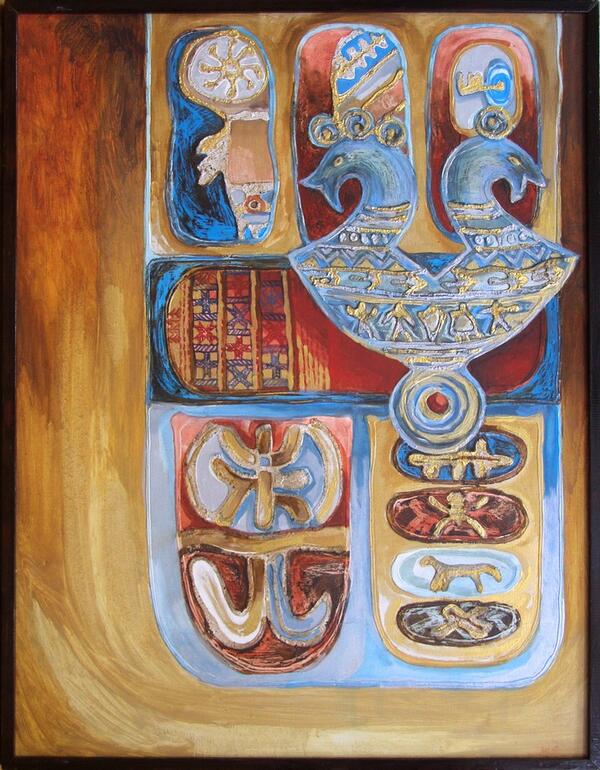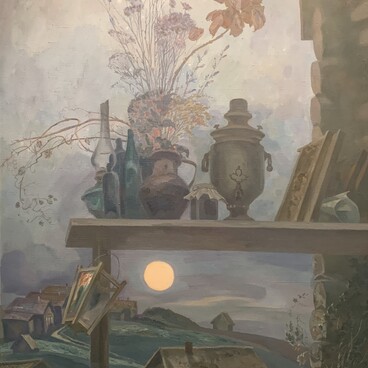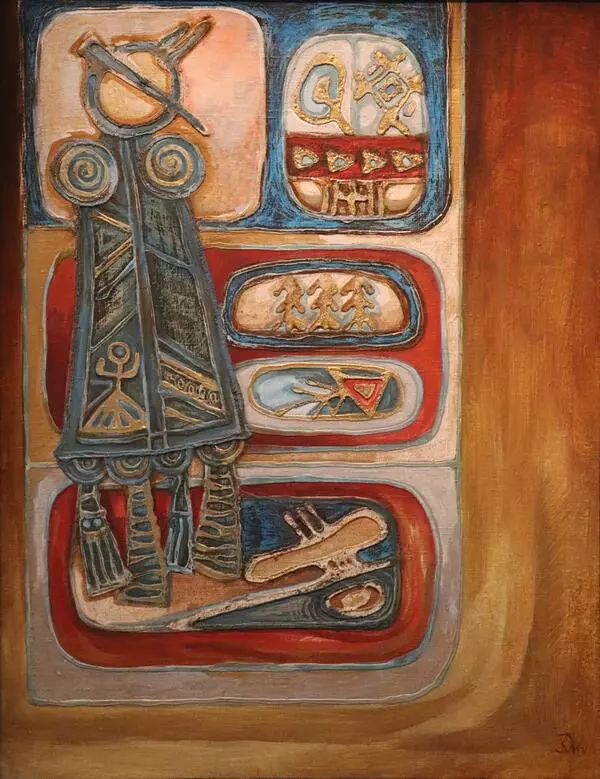At the end of the 20th century, among the Finno-Ugric peoples, at the crossroads of ethnic traditions and modernity, an original artistic movement, ethnofuturism emerged and became quite prominent. In their works, the Mordovian ethnofuturists combined features of archaic art and avant-garde, and conveyed ancient national traditions using modern stylized forms. Lyudmila Nikolaevna Kolchanova-Narbekova is considered one of the leading representatives of this trend. Her work is distinguished by originality, a wealth of meanings, conventionality of her imagery and at the same time an adherence to the traditions.
Lyudmila Nikolaevna Kolchanova-Narbekova was born in 1964. After graduating from college in Saransk, she continued her art education at the Vera Mukhina Higher School of Art and Design in Leningrad. The artist has held about 20 solo exhibitions in Russia and abroad: in Saransk and Moscow, Magdeburg and Helsinki, Vienna, Budapest and Ljubljana.
Lyudmila Kolchanova-Narbekova was inspired by the culture of the Mordovian people. When creating images, which are almost decorative in feel, the artist relied on ethnic archaism and at the same time explored the moral issues of being loyal to origins and traditions.
The triptych “Jewelry of the Mordva People of the Middle Tsna Area” reflects the beliefs of the Mordvins that live along the Tsna River, it is a Western ethnic group in terms of the residential area. A stylized geometric image in the shape of animals is painted on a light-colored background. The blue double-headed pendant on the right is decorated with a golden ornament.
According to the beliefs of the Mordvins, animal symbols protect from evil spirits and natural phenomena, before which people are defenseless. In addition, animals were considered an embodiment of ideal qualities. Thus, in the painting, horse heads on the pendant could be perceived as a symbol of patience, diligence and well-being, as the horse feeds the family.
In a stylized manner, the artist reproduced the patterns of Mordovian embroidery, which is based on a combination of geometric patterns and goes back to the symbolic representations of higher powers. A fashion designer by education, Lyudmila Kolchanova-Narbekova meticulously recreated the details and emphasized the texture of the objects. The color palette based on red, brown, and blue accents is characteristic of the Mordvins.
Lyudmila Nikolaevna Kolchanova-Narbekova was born in 1964. After graduating from college in Saransk, she continued her art education at the Vera Mukhina Higher School of Art and Design in Leningrad. The artist has held about 20 solo exhibitions in Russia and abroad: in Saransk and Moscow, Magdeburg and Helsinki, Vienna, Budapest and Ljubljana.
Lyudmila Kolchanova-Narbekova was inspired by the culture of the Mordovian people. When creating images, which are almost decorative in feel, the artist relied on ethnic archaism and at the same time explored the moral issues of being loyal to origins and traditions.
The triptych “Jewelry of the Mordva People of the Middle Tsna Area” reflects the beliefs of the Mordvins that live along the Tsna River, it is a Western ethnic group in terms of the residential area. A stylized geometric image in the shape of animals is painted on a light-colored background. The blue double-headed pendant on the right is decorated with a golden ornament.
According to the beliefs of the Mordvins, animal symbols protect from evil spirits and natural phenomena, before which people are defenseless. In addition, animals were considered an embodiment of ideal qualities. Thus, in the painting, horse heads on the pendant could be perceived as a symbol of patience, diligence and well-being, as the horse feeds the family.
In a stylized manner, the artist reproduced the patterns of Mordovian embroidery, which is based on a combination of geometric patterns and goes back to the symbolic representations of higher powers. A fashion designer by education, Lyudmila Kolchanova-Narbekova meticulously recreated the details and emphasized the texture of the objects. The color palette based on red, brown, and blue accents is characteristic of the Mordvins.





